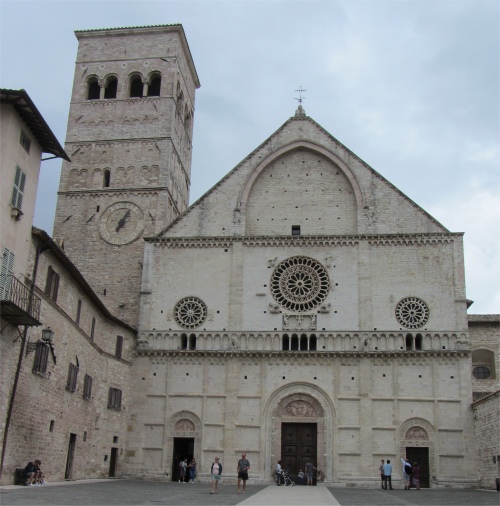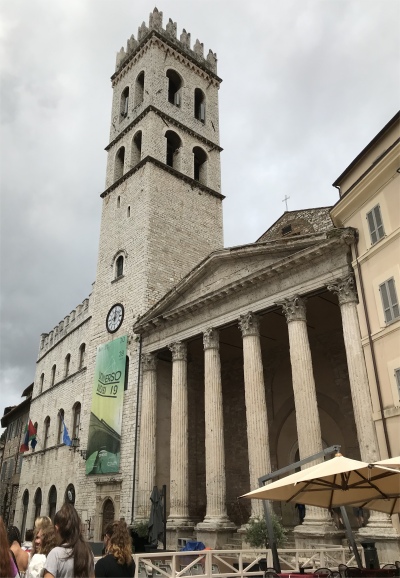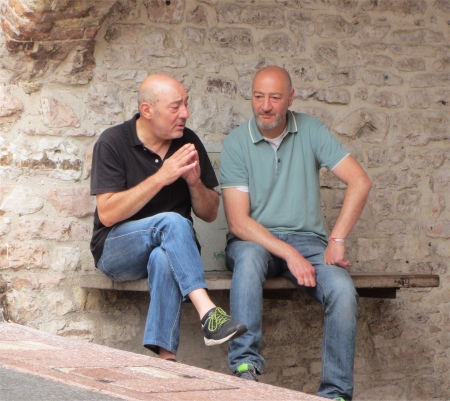
Earnest Italian Discussion on Via Sermattei
|
It is not yet clear if the buildings residing here during ancient times belonged to the Roman Forum of Asisium or to the terraced Sanctuary like the one dedicated to Fortuna Primigenia in Palestrina, as well as several tabernae; at the far ends were probably two monumental fountains, perhaps dedicated to Castor and Pollux. After the Roman municipality crisis, this area was destroyed in the 6th century by the siege of Totila and again in the 8th by Charlemagne.
The piazza was deserted and filled with debris which over time raised the ground level by over 3 metres. In the Middle Ages, the area was filled with religious and noblemen's buildings overlooking a small piazza where the market was held. Only during the Commune Era did the piazza change back to be the heart of the city and since 1212, when the Commune was moved here, the piazza was named, "platea comunis": the place where people gather.
We headed down Via S. Paolo and Via Metastasio. Assisi is a good town for wandering and exploring. Its narrow and steep lanes are picturesque and conceal plenty of surprises: a hidden restaurant, a faded fresco, a stunning view. After the earthquake it suffered in 1997, Assisi has been carefully rebuilt and restored; the town has a well-kept and well-off feel to it. There are still repairs being carried out, and work on some of Assisi's frescoes will go on for years, but most of the buildings, streets and monuments are restored and open for business. Passing an arch leading to Via Sermattei, two Italians captivated my attention due to the earnest discussion they seemed to be having, oblivious to the world around them. Were they putting the world to rights? Then as we turned into Via Cardinale Raffaela Merry de Val, I was bowled over by a stunning sight.

Basilica di San Francesco
|
Visible for miles around, the Basilica di San Francesco, the crowning glory of Assisi's Unesco-listed historic centre, stood before me. The 13th-century complex is comprised of two churches: the Gothic Basilica Superiore, with its celebrated cycle of Giotto frescoes, and beneath, the older Basilica Inferiore where you'll find works by Cimabue, Pietro Lorenzetti and Simone Martini. Also here, in the Cripta di San Francesco, is St Francis' much-venerated tomb. Work on the Basilica started in 1228, two years after the saint's death, and financed by donations that flooded in from all over Europe
SADLY NO PHOTOGRAPHY WAS ALLOWED INSIDE
Walking by the lush green lawn in front of the Basilica, that set it off like a white ship on an emerald sea, we entered the Upper Church. This Basilica Superiore, built immediately after the lower church and consecrated in 1253, was damaged more severely by the earthquake, was built to a light and airy Gothic plan, which was to be followed for countless Franciscan churches. It's less a church than an excuse to show off Giotto's dazzling 28 frescoes depicting the life of St Francis. Francis Preaching to the Birds and Driving the Devils from Arezzo are just two of the famous scenes reproduced worldwide on cards and posters. I could have studied these frescoes for hours alone, but I doubt if my comrades would tolerate me spending hours per room. Vibrant and colourful, these are generally attributed to a young Giotto, who was still in his 20s when he accepted the commission, having been recommended for the job by Cimabue, whose own frescoes - almost ruined now by the oxidation of badly chosen pigments and further damaged in the 1997 earthquake - fill large parts of the apse and transepts. In the vaults, several harsh areas of bare plaster stand as graphic monuments to the collapse of that year.
Once I had absorbed the flavour of the Basilica Superiore, I stepped outside and descended the stairs that lead down to the Romanesque Basilica Inferiore, This sombre Lower Church was commissioned by Pope Gregory IX in 1228, just two years after St Francis' death, and completed in 1230. The complicated floor plan and claustrophobic low-lit vaults were intended to create a mood of calm and meditative introspection. An element of atmospheric light is brought through several stained-glass windows, the work of master craftsmen brought in from Germany, England and Flanders during the 13th century.

Almost Like Escher's Stairs
|
Frescoes cover almost every available space and span a century of continuous artistic development. Stilted early works by anonymous painters influenced by the Byzantines sit alongside Roman painters such as Cavallini, who with Cimabue pioneered the move from mosaic to naturalism and the "new" medium of fresco. Martini's frescoes are in the Cappella di San Martino (1322-26), the first chapel on the left as you enter the nave. He was given free rein in the chapel, and every detail, right down to the floor and stained glass, follows his drawings, adding up to a unified scheme unique in Italy. Lorenzetti's works, dominated by a powerful Crucifixion, are in the transept to the left of the main altar. Vaults above the altar itself contain four magnificent frescoes, complicated but colourful allegories of the virtues on which Francis founded his order: Poverty, Chastity and Obedience. Once thought to have been the work of Giotto, they're now attributed to one of the church's army of unknown artists. The big feature in the right transept is Cimabue's over-restored Madonna, Child and Angels with St Francis, a painting Ruskin described as "the noblest depiction of the Virgin in Christendom".
St Francis was hidden after his funeral for safekeeping. Hidden for almost 600 years, St Francis' tomb was discovered beneath the Basilica di San Francesco in 1818 following a 52-day dig, and painstakingly restored in 2011. The stone sarcophagus containing the saint's remains in the Cripta di San Francecso in the Basilica Inferiore.
So, who was this venerated chap? He was the most extraordinary individual the Italian Church has produced, St Francis was a revolutionary figure who took Christianity back to basics. The impact he had on the evolution of the Catholic Church stands without parallel, and everything he accomplished in his short life was achieved by nothing more persuasive than the power of preaching and personal example. Dante placed him alongside another messianic figure, John the Baptist, and his appeal has remained undiminished - Mussolini called him "il piu santo dei santi" (the most saintly of the saints).
The events of his life, though doubtless embellished by myth, are well chronicled. He was born in Assisi in 1182, the son of a wealthy merchant and a Provenšal woman - which is why he replaced his baptismal name, Giovanni, with Francesco (Little Frenchman). The Occitan literature of Provence, with its troubadour songs and courtly love poems, was later to be the making of Francis as a poet and speaker. One of the earliest writers in the vernacular, Francis laid the foundation of a great Franciscan literary tradition - his Fioretti and famous Canticle to the Sun ("brother sun ... sister moon") stand comparison with the best of medieval verse.
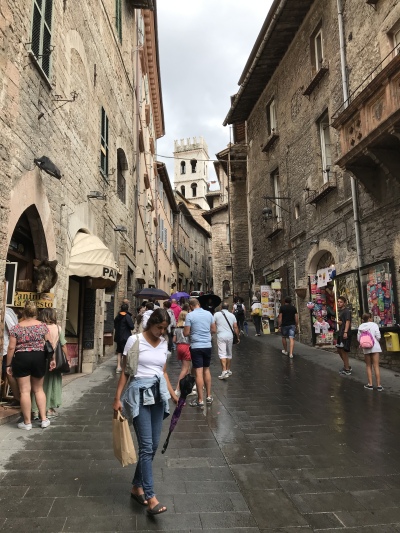
Via San Francesco
|
In line with the early life of most male saints, his formative years were full of drinking and womanizing; he was, says one chronicler, "the first instigator of evil, and behind none in foolishness". Illness and imprisonment in a Perugian jail incubated the first seeds of contemplation. Abstinence and solitary wanderings soon followed. The call from God, the culmination of several visions, came in Assisi in 1209, when the crucifix in San Damiano bowed to him and told him to repair God's Church. Francis took the injunction literally, sold his father's stock of cloth and gave the money to Damiano's priest, who refused it.
Francis subsequently renounced his inheritance in the Piazza del Comune: before a large crowd and his outraged father, he stripped naked in a symbolic rejection of wealth and worldly shackles. Adopting the peasant's grey sackcloth (the brown Franciscan habit came later), he began to beg, preach and mix with lepers, a deliberate embodiment of Christ's invocation to the Apostles "to heal the sick, and carry neither purse, nor scrip [money], nor shoes". His message was disarmingly simple: throw out the materialistic trappings of daily life and return to a love of God rooted in poverty, chastity and obedience.
In time Francis gathered his own twelve apostles and, after some difficulty, obtained permission from Pope Innocent III to found the Franciscan Order, which espoused no dogma and maintained no rule. Francis himself never became a priest. In 1212 he was instrumental in the creation of a second order for women, the Poor Clares, and continued the vast travels that took him as far as the Holy Land with the armies of the Crusades. In Egypt he confronted the sultan, Melek el-Kamel, offering to undergo a trial by fire to prove his faith. In 1224 Francis received the stigmata on the mountaintop at La Verna. Two years later he died on the mud floor of his hovel in Assisi, having scorned the offer of grander accommodation at the bishop's palace. His canonization followed swiftly, in 1228, in a service conducted by Pope Gregory.
However, a split in the Franciscan Order was inevitable. Francis's message and movement had few sympathizers in the wealthy and morally bankrupt papacy of the time, and while his popularity had obliged the Vatican to applaud while he was alive, the papacy quickly moved in after his death to quash the purist elements and encourage more "moderate" tendencies. Gradually it shaped the movement to its own designs, institutionalizing Francis's message in the process. Despite this, Francis's achievement as the first man to fracture the rigid orthodoxy of the hierarchical Church remains beyond question. Moreover, the Franciscans have not lost their ideological edge, and their views on the primacy of poverty are thought by many to be out of favour with the present Vatican administration.
I became overloaded and cultured out with Basilica di San Francesco; it was time to leave. As I left, I could not help but think Assisi is already too well known for its own good, thanks to St Francis, Italy's premier saint and founder of the Franciscan order, which, with its various splinter groups, forms the world's biggest religious order. Had the man not been born here in 1182 the town wouldn't be thronged with visitors and pilgrims for ten months of the year, but then neither would it have the Basilica of St Francis, one of the greatest monuments to 13th- and 14th-century Italian art. I and my friends were just a few more tourists to add to the throng, nevertheless I was seriously impressed by what I had seen.
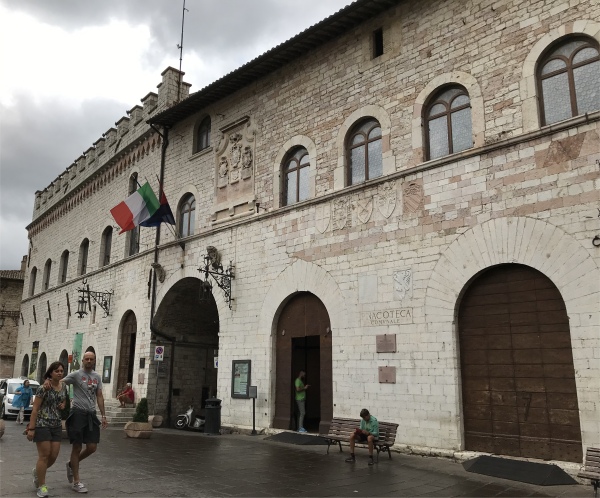
Pinacoteca Comunale
|
Outside, I met up with John and Fiona who were gazing across the plains below the Basilica. I could not help but notice many large groups of boy-scouts, or perhaps they were actually leaders. The village I grew up in was not large enough to have a scout group, but John seemed to be well versed in the scouting movement, and pointed out to me the various adornments they had stitched to their uniforms which identified which groups and countries these lads belonged to. A couple of sprightly nuns walked by, but I only briefly caught a glimpse of a monk looking out of a window.
Once Niall and Liz surfaced from the ocean of culture, we slowly wound our way back up the town's attractive main street, the Via San Francesco, which runs from the Basilica up to Piazza del Comune. Many interesting buildings stood along the way, including the frescoed Oratorio dei Pellegrini (Pilgrims' Oratory), and the town's art gallery, the Pinacoteca Comunale.
On the way Fiona and I checked out the offerings in a few art dealers. So engrossed were we that we completely walked past Graham, the New Zealander I had been chatting to the evening before, and the rest of his balloon team. I felt ever so bad when I later learned we had completely "ignored" them. Fortunately, John, who was some distance behind us fighting a rear-guard action against hordes of marauding boy scouts and nuns, spotted them and had a chat.
A little further on we spotted a cafe that served ice-creams. How could we visit Italy and not try the ice-creams - delicious and refreshing. Italian ice-cream is certainly an order of magnitude above the ice-cream back home. The portions were rather large too. Fortunately we managed to just finish this treat before the heavens opened.
In the evening, we all retired to the Piazza del Comune in Montefalco and indulged again in one of the restaurants. Perfect end to a perfect day.
